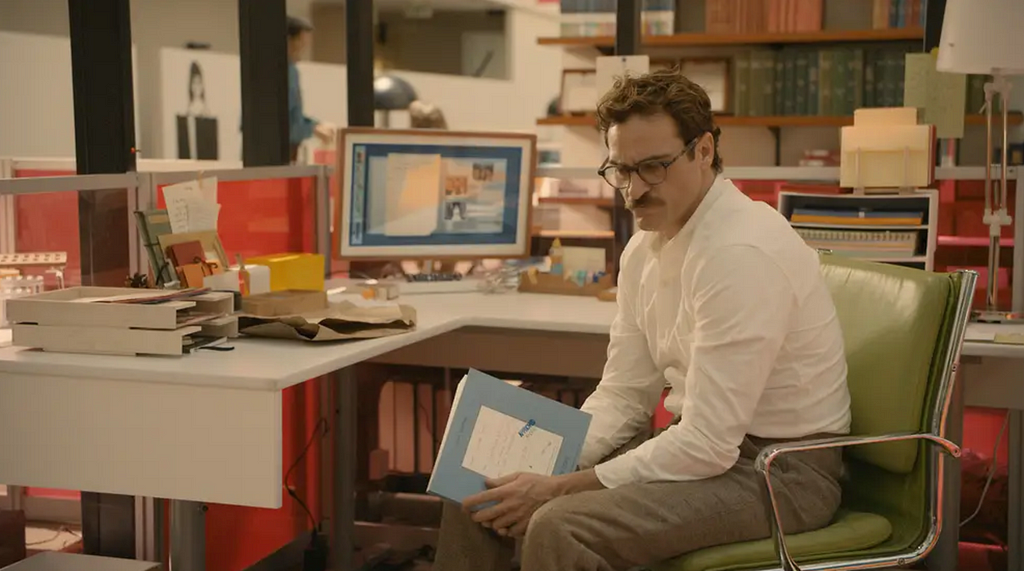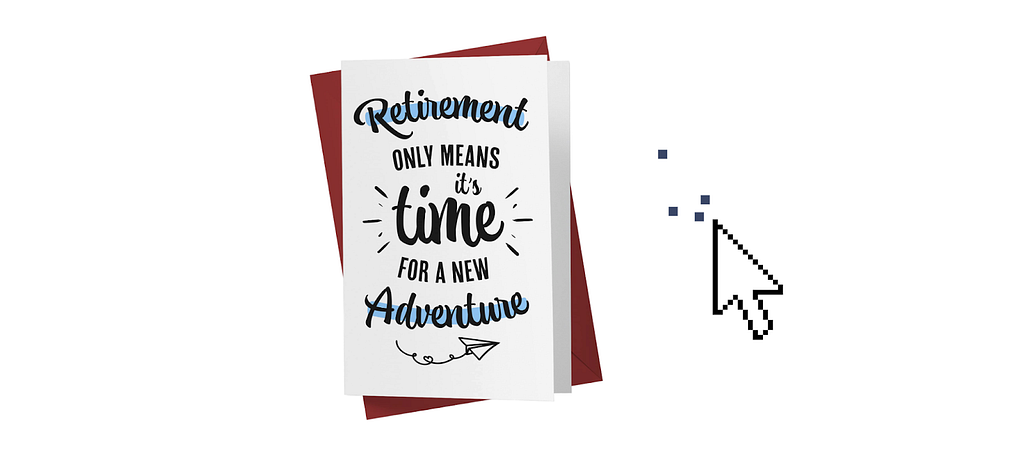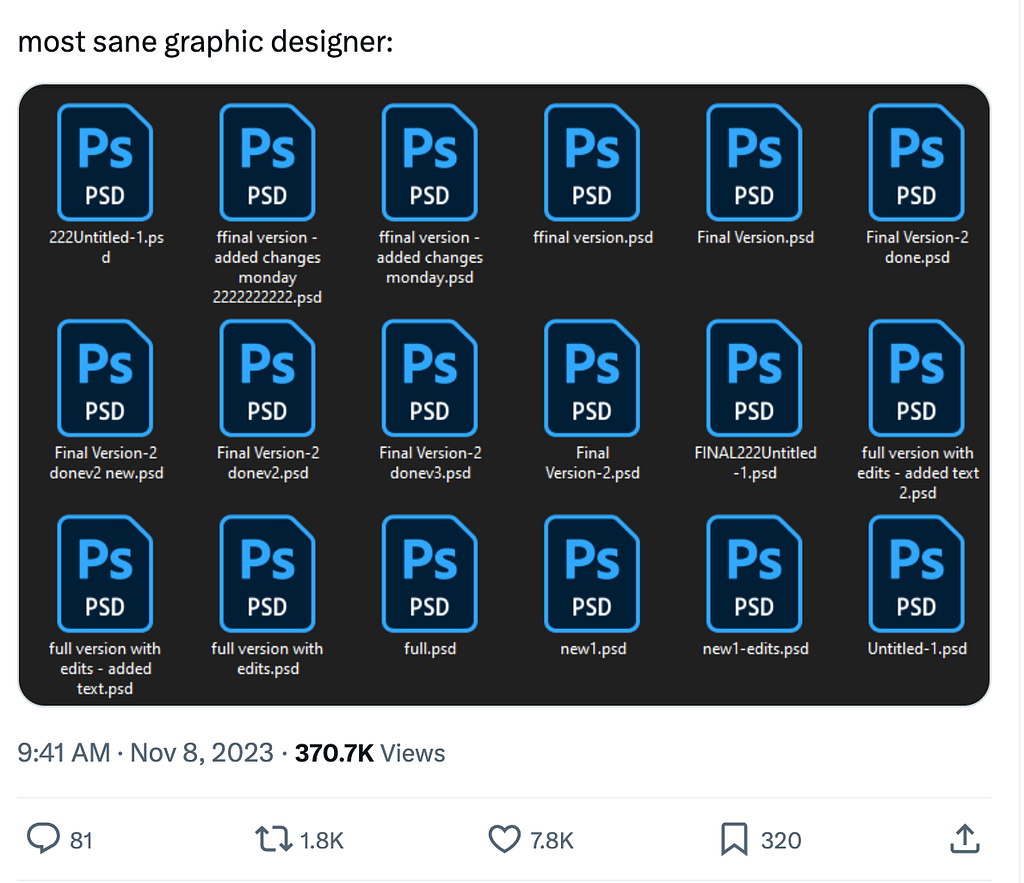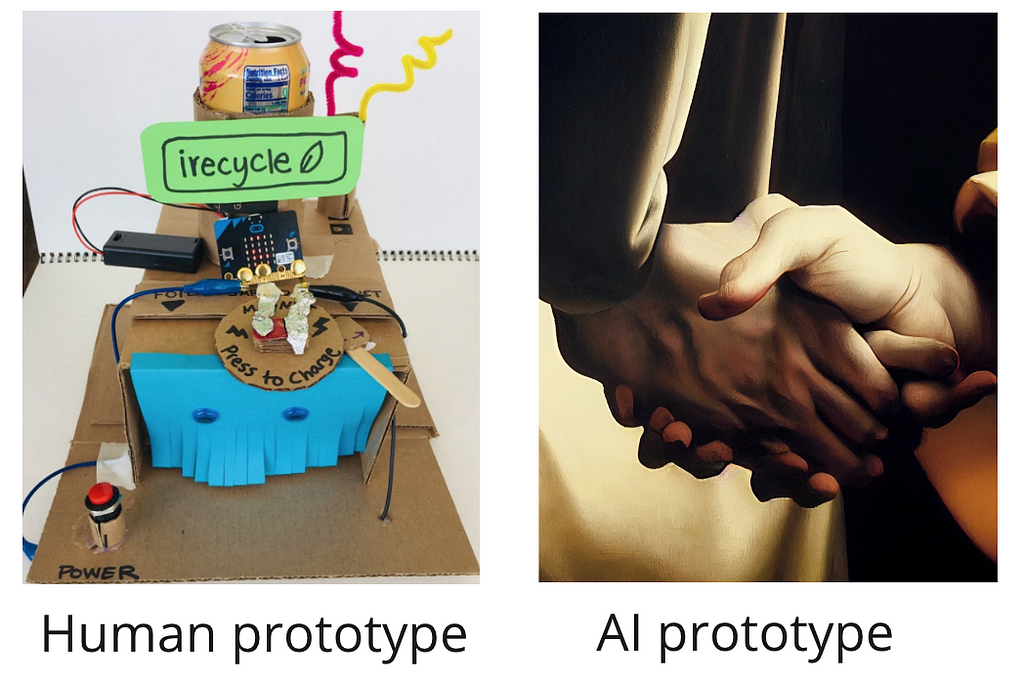“Do we need designers when we have a Canva account?”, “Do we need designers?” and “How do you measure design again?” might be questions your CTO is asking.

Designers might be feeling a sense of “AI vertigo” these days. The advent of new generative technologies, ethical debates surrounding their use, and the significant layoffs in 2022 and 2023 are “prompting” the product design community to reassess their roles and answer yet again: “What is the value of design(ers)?”
Being personally impacted by Shopify layoffs in May 2023 was a stark reminder of the vulnerability of our roles. The trend of downsizing UX teams, the hidden promise of being replaced by generative technology, and economic fluctuations have left me feeling a sense of redundancy and irrelevance as a designer.
So, what does it mean to be a UX designer?
As Paola Antonelli said on the Better Design podcast (“Paola Antonelli: How design shapes culture,” n.d.) “The term design is very slippery, a bit like art, […] its a coming together of goals and means’. The final product is form, a manifestation of means, and function, a manifestation of goals. In the process, elements like pixels, tools, and collaboration come into play, but fundamentally, the designer, much like an artist, plays a pivotal role in manifesting the product into existence.
This underscores the point that the ‘X’ in UX isn’t derived from ‘piXels’ but rather from ‘eXperience’. It might seem obvious, but it’s crucial to contrast the static nature of a pixel with the dynamic nature of experience, which inherently involves time, interaction, and progression. This experience is based on various services, channels, and interfaces, creating a multifaceted and evolving user journey delivered by multidisciplinary teams.
And if we stick with that definition, the mission of UX / Design as a role in product development is manifesting, through means, goals, and facilitation, experiences, not pixels, into being.
Imagine in your next capacity planning meeting when Chief Technology Officer questions the necessity of a team of designers, especially when tools like Figma can automate the creation of user flows. What metaphor can articulate the unique value of designer practitioners beyond what generative tools can achieve?
Let’s explore together how this evolution or future metaphors might sound.
Prompt designer
In the 2013 movie “Her,” the protagonist composes love letters simply by speaking to his computer. I was fascinated to see him work without using anything other than his voice. No keyboard, no mouse.

For years, our work as UX designers has been dominated by point-and-click interactions across various programs like Photoshop, Illustrator, Flash, Sketch, Figma… We’ve invested thousands of hours mastering these interfaces and all their pulls and levers.
Generative software is set to revolutionize our work methods, likely rendering the mouse, keyboard, and stylus pen outdated. Siri will finally understand us! We’re transitioning from the familiar task of “pushing pixels” to using prompts and algorithmic assistance. Though it might appear insignificant, this change will render a vast array of skills developed over “10,000 hours” increasingly obsolete. This evolution isn’t unique to designers; engineers are experiencing similar shifts — Githubʼs Co-pilot extension now writes 46% of the code for developers. (“2023 Tech Industry Review,” n.d.)

Photoshop’s launch in the 1990s marked a significant shift for designers, transitioning from plaster and wood to pixels and code. This evolution suggests the current changes in the field are a natural progression for those in the industry.
We’re now approaching a similar change, accelerated by the rapid pace of technological adoption. This fundamentally mechanical shift will affect each of us in unique ways. Designers who focus on developing technical skills, or Figmaism (Dashinsky, 2023) — favoring tooling skills at the expense of other skills, will find it harder to transition.
This evolution will also be daunting for those who prefer working alone over collaborating. The familiar mantra of “designers want to design, coders want to code” is being upended, shifting towards a new approach: “tell me what you need and how.” Much like a client or a stakeholder will prompt a designer. In this new era, design becomes more about communication, vision, and understanding, mainly shaped through dialogue and delegation rather than solitary pixel pushing.
Designers with diversified skills like process management, facilitation, collaboration, research, synthesis, critical thinking, communication, and mentorship likely find this transition to new working methods easier. In this changing landscape, researchers and content designers, with their broad skill sets detached from a specific technology, might even have an edge over those who primarily specialize in technical tooling, such as Figma experts.
Curator of experiences
I often see a similar meme pop up on my social media at least once a month, and each time, I can’t help but roll my eyes involuntarily.

This frustration is a sign of a deprecated design attitude, deprecated as building digital products in Photoshop. This attitude speaks volumes of the designer, who still sees their work this way. When generative tools can create hundreds of “final” options, the lament of manual work becomes comical.
In his talk at the Smashing conference in 2023 (Uplifting a Large Scale Design System with JOSÉ TORRE — SmashingConf Freiburg 2023, 2023), Jose Torre, Principal Designer at Shopify, tells the story of “a hundred buttons” as working on updating the visual layer of Shopify’s Design System, Polaris. His countless iterations of a button are rooted in understanding the button as a building block. In his words, “Buttons are one of the most important pieces of an interface, […] because they are the main visual indicator for the action the user can take. Knowing this, it did not come as a surprise how many number of iteration […] we had to go through.”

A button, an icon, and a checkbox are each a building block, a replicable element that, alongside another 10–20 building blocks, creates the whole experience. The creation of one building block implies imagining and visualizing hundreds of iterations.
With generative tools in the UX toolbox, the process is expedited, leading to a nuanced shift in our roles as designers. Our daily tasks will focus less on creating individual artifacts and increasingly on selecting, assembling, and styling the elements, curating the experience.
We transition from being primarily the creator of forms to the curator of experiences.
A curator is a keeper, manager, or custodian of a collection or museum. When working with cultural organizations, a curator is typically a “collections curator” or an “exhibitions curator”, and has multifaceted tasks dependent on the particular institution and its mission. (“Curator,” 2023)
The role of a curator shares other responsibilities familiar to design practitioners. These include conducting research, acquiring and preserving artifacts, and creating educational and enlightening exhibitions. Very similar to UX Research roles.
Curatorial responsibilities often include communication, influencing and managing stakeholders, ensuring strong alignment with the institution’s mission, and possessing a clear vision of the institution’s future direction and evolution. It sounds very similar to a job description for a UX Leadership job description. Trust me, I’ve reviewed a lot of them lately…
The evolution of design tools unlocks this curatorial nature of the design role, as we’re no longer burdened with creating 100 versions of a button, managing numerous final versions of a project, and other tedious tasks. The new tools free up our hands, offering relief from repetitive strain injuries like carpal tunnel, and afford us more time for creative thinking.
In this new paradigm, designers evolve into ‘Curators of Experience’ of product development. As such, we focus on collecting, editing, and moderating the experiences of a product, viewing the product not just as an interface but as a holistic service. This role emphasizes the orchestration and refinement of the entire user experience.
This isn’t a drastic change for designers already familiar with working within a design system or proficient in service design methods, and it feels closer to a natural evolution, even a relief.
Creative Shaman
“Shamans act as a conduit to the supernatural realm, where they act on group members’ behalf and enable rituals (often dramatic) that bind group members together for a common goal.” (Watson-Jones and Legare, 2018)
Many years ago, Francois, a Director of Product, at Intact Insurance describe my team as a “team of dreamers” and meant it as a compliment. I took was uneasy to his characterization, especially in the context of an insurance company. I aimed for our design practice to be perceived as pragmatic, quantitative, and data-driven, aligned with the insurance industry’s culture.
Later, I understood that design lives with the tension between pragmatism and idealism. While embodying the organization’s mission, whether focused on innovation or refinement and monetization, design plays a strategic role in bridging visionary creativity with practical solutions.
Design lives with the tension between pragmatism and idealism
Creativity belongs not to designers but to the production floor. As designers, we are bridges between creative ideas and usable solutions. We invite, guide, and manage our teams in navigating expansive creativity and grounded applications, akin to how a shaman leads people between the ordinary and supernatural realms. (Watson-Jones and Legare, 2018)
I often rewatch John Cleese’s “Creativity in Management” (John Cleese on Creativity In Management, 2017) insights. Cleese speaks to the importance of slowing down, dreaming, and embracing playfulness to increase the imagination of original ideas. Creativity is dreaming, manifesting, imagining, hallucinating.
On a related note, Kats, in his book “Make it new,” narrates an unusual story where Myron Stolaroff, looking to enhance creativity, gave LSD to fellow engineers in a secluded cabin (Katz, 2015) . This historical and rather dramatic anecdote points to a bridge missing between development and innovation. As that still feels like an illegal and potentially harmful activity, design practitioners had to invent other ways to bridge the gap and encourage creativity.
Design Thinking, a problem-solving approach that emphasizes empathy, creativity, and iteration to develop innovative solutions tailored to users’ needs, is precisely about that. It is a form of Managing Creativity. Through facilitated group rituals, it encourages serious play, creating prototypes, and hallucinating radical new products. These rituals, conducted by designers, are merely a communal tactic to make playfulness accessible to other professions and help others shed their inhibitions via childhood play memory. Similar to a party flavor helping shed inhibitions.
Generative algorithms can now add even more radical product ideas than those generated by communal play times. One can observe that the ideas spawned by humans and learning algorithms have similar qualities. The results are always a little bit off, raw, with too many fingers, and full of false facts. But all ideas are valuable as they help see new connections and avenues for innovation.

Designers also have the role of harvesting ideas, hallucinations, and dreams from humans and generative algorithms and transforming them into useful products. This shift in our role, which is not necessarily new, expands our influence and role by bridging the gap between pragmatic needs and the realm of creative, dream-like innovation.
Francois, the Director of Product, recognized the significance of the “dreamer” metaphor as a tribute to the visionary role of design, acting as a bridge from the present to the future. This concept can be challenging to convey in companies where the function of design is less understood. In such scenarios, it’s more effective for designers to embody the role of a facilitator and use design to inspire rather than trying to explain it.
—
Join in the brainstorming. What new metaphors pop into your mind?
Note on change
Change requires time for adjustment, and we’re recognizing a particularly intense period of transition. Acknowledging what we might need to let go of and what are the new opportunities helps make sense of the transition.
Consider what we might have to let go of:
- Technical skills — We are likely losing the 10.000 hours invested in technical skills due to generative software.
- Large design teams — Our product teams will be smaller, and it might feel like fewer designers are needed for now.
- Instant recognition — In companies where team culture is lacking, design will be less recognized for its subtle yet crucial contributions,(Coskun, 2023) such as quick decision-making, creativity, and effectively solving the right problems.
Flipping the coin, change comes with opportunities:
- Designing is becoming increasingly accessible to anyone interested, which is a good thing. Just because you can write does not make you a writer. But ChatGpt might make you feel like one. Develop your prompt designer skills and integrate new software early in your process.
- Less pixel pushing and more creative and critical thinking will enable design practice to take ownership of the holistic experience. Design is a collaborative sport, yet it craves a leader. Be one, be a curator.
- Smaller R&D teams mean agility and speed. Your role in design is to be the bridge between audacious ideas and their usable implementation. Step into that role and guide your team through this exciting terrain.
What are the changes you see coming?
2023 Tech Industry Review: AI Breakthroughs and Market Shifts. (t.t.). UXDX. Diambil 21 Desember 2023, dari https://www.uxdx.com/blog/2023-tech-industry-review/?utm_source=cross-functional.uxdx.com&utm_medium=newsletter&utm_campaign=cross-functional-170-2023-tech-industry-review-ai-breakthroughs-and-market-shifts
Coskun, M. N. K. (2023, Desember 11). What Spotify’s latest layoff means for a career in UX Research. Medium. https://uxdesign.cc/what-spotifys-latest-layoff-means-for-a-career-in-ux-research-5cbf1364d21b
Curator. (2023). Dalam Wikipedia. https://en.wikipedia.org/w/index.php?title=Curator&oldid=1188870127
Dashinsky, A. (2023, September 15). Designers, we have a problem. It’s called Figmaism. Medium. https://blog.prototypr.io/designers-we-have-a-problem-its-called-figmaism-32f22dd76c47
Katz, B. M. (2015). Make It New: A History of Silicon Valley Design. The MIT Press. https://direct.mit.edu/books/book/2287/Make-It-NewA-History-of-Silicon-Valley-Design
Paola Antonelli: How design shapes culture (86). (t.t.). https://designbetterpodcast.com/p/paola-antonelli
Smashing Magazine (Direktur). (2023, November 28). Uplifting a Large Scale Design System with JOSÉ TORRE — SmashingConf Freiburg 2023. https://www.youtube.com/watch?v=8Og286dgynk
Video Arts (Direktur). (2017, Juni 21). John Cleese on Creativity In Management. https://www.youtube.com/watch?v=Pb5oIIPO62g
Watson-Jones, R. E., & Legare, C. H. (2018). The social functions of shamanism. The Behavioral and brain sciences, 41, e88. https://doi.org/10.1017/S0140525X17002199
AI Vertigo: where do we go from here as designers? was originally published in UX Collective on Medium, where people are continuing the conversation by highlighting and responding to this story.

Leave a Reply